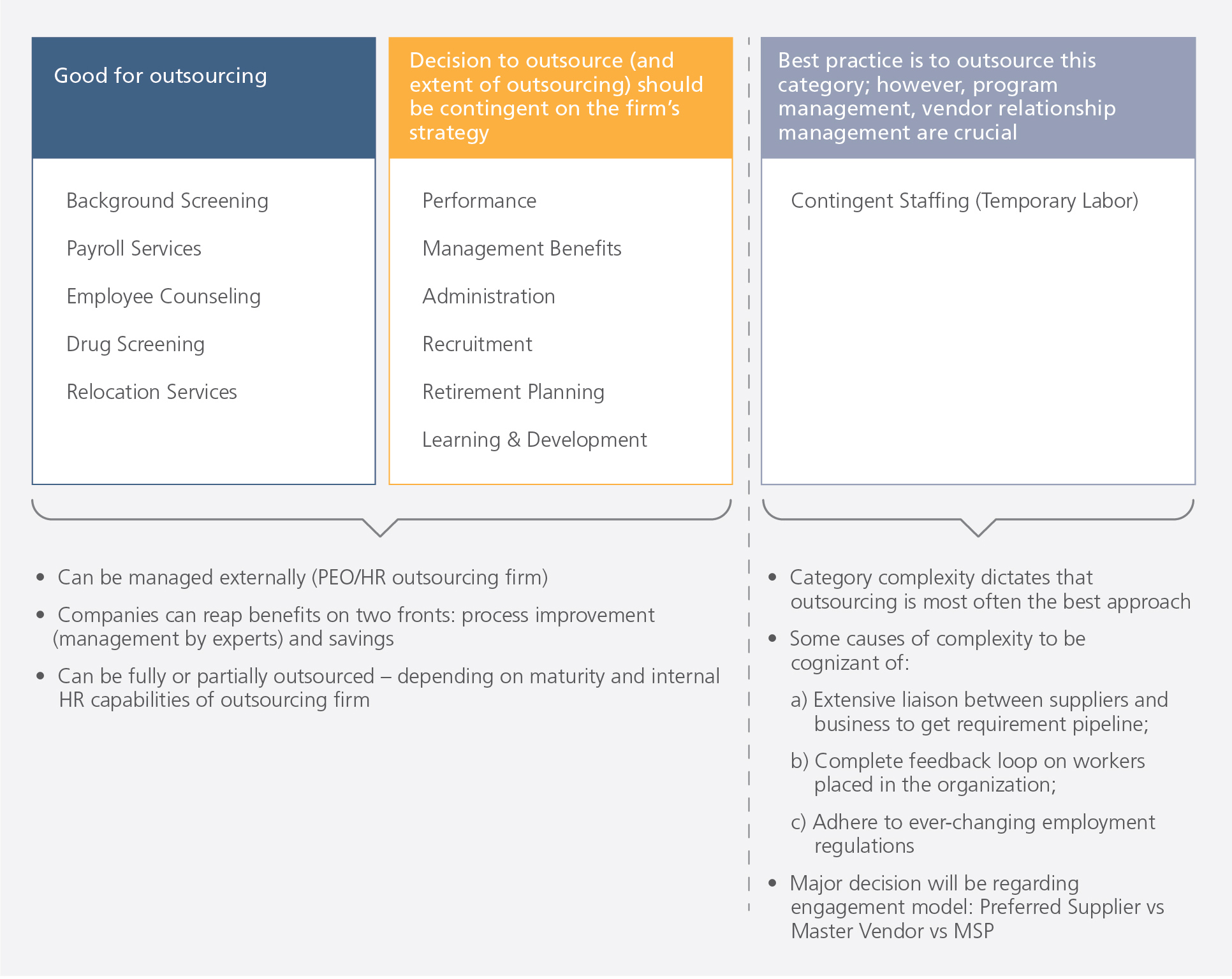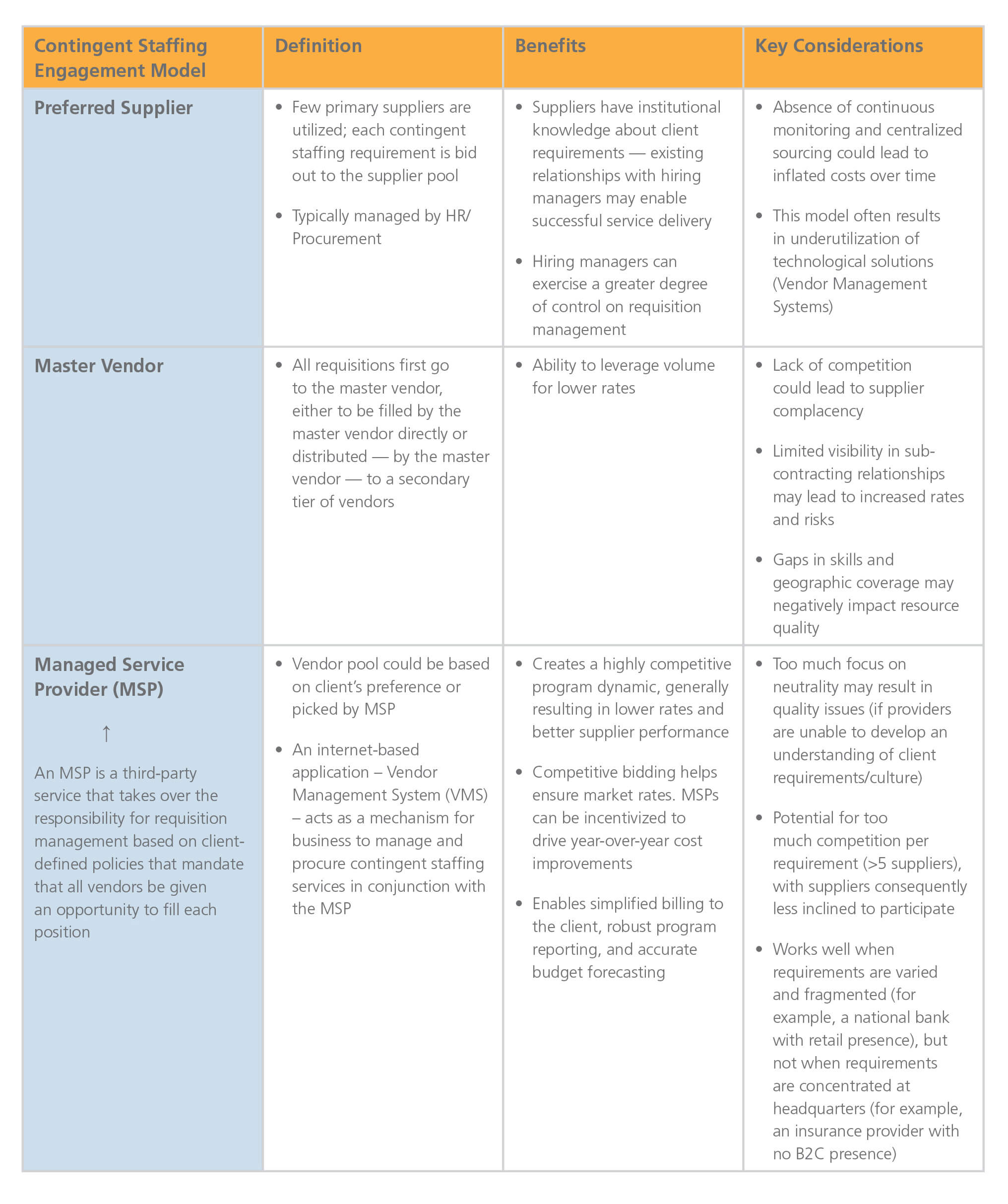Outsourcing Human Resources (HR) operations is a hot-button topic with many senior Banking, Financial Services, and Insurance (BFSI) industry executives.
Indeed, outsourcing some HR operations can free up resources, cut costs, boost process efficiency and help channelize resources to mission-critical activities. But the decision to outsource is far from straightforward, requiring several complex considerations relating to sourcing, program administration and risk control.
This report explores outsourcing of HR in the BFSI sector; whether it makes sense for different types of financial services firms to consider partial or complete outsourcing of the category, which aspects to outsource, and to which outsourcing partners.
What’s Inside:
- Critical distinctions between offshoring and outsourcing
- The case for outsourcing HR — and pro tips to get it done
- Important program-related considerations
- How to select the right contingent staffing model
Read it now for some expert guidance to help inform your outsourcing decisions and strategy.
The Financial Services sector comprises a broad range of businesses including banks, insurance companies, credit unions, mortgage corporations, investment funds, and stock brokerages. The years following the financial crisis have seen the sector forced to deal with increased regulation, higher capital requirements for banks and insurers, as well as the need to implement robust processes across the board. Furthermore, customer expectations regarding service quality have sky- rocketed. It is against this backdrop of rising compliance costs, capital requirements and customer expectations that we look at outsourcing of Professional Services in this report.
The global Business Process Outsourcing (BPO) industry — including outsourcing of functions such as Human Resources, Customer Relationship Management, Finance and Accounting, and Knowledge Process Outsourcing — had revenues of over $140 billion in 2016. At the outset, it is important to distinguish between offshoring and outsourcing.
Simply put, “offshoring” refers to getting work done in a different country, while “outsourcing” refers to an organization contracting work out to a third party which may or may not be in a different country. While the phenomenon of “offshoring” may be buffeted by the winds of prevailing political sentiment, the practice of “outsourcing” has proven its enduring value. Although overseas BPO service providers have had concerns about increasing trade protectionism in the U.S., the growth prospects for the BPO services industry as a whole appear bullish.

The case for outsourcing has three main arguments:
- The swelling pressure on operational margins meant that it made financial sense for firms to outsource non-strategic functions to specialist firms. These specialists leveraged economies of scale, deep functional expertise and lower costs of labor to deliver savings.
- As outsourcing firms became more mature and moved up the value chain, clients saw the potential to achieve more than savings. Best-in-class service providers can add value by actually implementing and managing industry-standard processes for support functions such as HR – a boon for large financial institutions with operations in far-flung corners of the globe, as well as for small and medium-sized enterprises which lack the resources and/or expertise to manage these areas effectively.
- Outsourcing enables businesses to focus on their core competencies. The argument is that shareholders will be better served if the business maintains a laser focus on what they do best, while outsourcing the rest to “specialists,” who will likely do a better job than the firm.
HIGH-LEVEL THOUGHTS TO GUIDE THE OUTSOURCING DECISION
The primary aim of the decision to outsource is often margin improvement by cutting costs. Outsourcing partners are further expected to bring in process efficiencies or improvements by virtue of their domain experience, while keeping customer experience intact.
Bearing in mind these three criteria – cut costs, improve processes, improve or at least maintain customer experience – will help firms identify activities that are most apt for outsourcing, as well as effectively administer outsourcing programs.
This report will discuss the outsourcing of Human Resources (HR, hereafter) services. For Financial Services firms, what aspects of HR does it make sense to outsource, and why? We will also look at some important sourcing and program administration considerations within this category, followed by a deeper dive into “Contingent Staffing:” a sub-category of particular relevance to the Financial Services sector, and one with many nuances.
Why Outsource HR?
The top two reasons for outsourcing HR, as with most other categories, are cost and time efficiencies. These are particularly significant for smaller firms which spend time, effort and money — that would be better employed in growing the business — on HR tasks. Other reasons cited by the SHRM (Society of Human Resource Management) include improved compliance, a wide range of offered services, and more experience in the HR field.
All HR functions — including and not limited to background screening, retirement planning, performance management and contingent labor — can be outsourced. The extent of outsourcing primarily depends on the outsourcing firm’s overall “strategic” view of how core HR is to the company.
Another important factor that impacts the HR outsourcing decision is the size of the company. While smaller companies can consider a more comprehensive approach to HR outsourcing in terms of functions outsourced and control ceded to the outsourcing partner, the size and geographic spread of the employee base in mid-to-large financial services firms makes complete outsourcing inadvisable as well as impractical.
Three important, inter-related questions need to be considered when evaluating whether to outsource HR. These are:
1. How much control to relinquish?
Governance and program management depend on the extent of HR outsourcing. A company can choose to partially outsource its HR and share responsibilities with its vendors. Alternatively, it could completely outsource HR — with the vendor taking on all HR administration responsibilities and the responsibility of HR managers in the original company shifting to vendor management and ensuring that business requirements are satisfactorily met. The extent of outsourcing would depend on the functions outsourced, as well as the internal HR capabilities of the outsourcing firm.
2. What HR functions to outsource?
The functions to be outsourced are often decided on the basis of in-house competencies, as well as the firm’s appetite to manage the vast cost center that would emerge should every HR function be internally owned and managed as per best-in-class standards.
- Categories that are good candidates for complete outsourcing include background screening, payroll services, and drug screening; most companies are open to outsourcing these “non-core” HR functions. These are more transactional functions and outsourcing them to specialist firms often yields dual benefits of lower cost as well as better process flow and adherence.
- Relocation services are also well suited for outsourcing, as experienced partners provide immense value through their wide geographic coverage, visa and immigration relationships, ensuring compliance to various legal and tax regimes and assisting relocated employees with the “nuts and bolts” of their transition to a new location — finding schools, property acquisition/disposal, etc.
Other functions like healthcare benefits and performance management are more complicated — while their administration can be outsourced, many companies are reluctant to relinquish control of such sensitive domains. Recruitment is another function whose outsourcing would depend on company and region-specific nuances; there is no single “correct” or “one-size-fits-all” model. Recruitment Process Outsourcing (RPO) is a model wherein the execution of a company’s chosen hiring strategy is handled by an external partner. RPOs can manage the entire recruitment process — either by using the company’s own staff if resources with the right skillsets are available, or by bringing in their own team of recruitment specialists. Agencies are another option that can be used to quickly plug talent gaps — however, with placement fees often between 20-30 percent, they aren’t always the most economical. Another interesting phenomenon is the rise of crowdsourcing — companies using their employee base to source referrals for certain roles.
- Contingent Staffing is a category that requires a different approach to outsourcing than most other categories; most companies do not have the resources and expertise to manage this category internally and would benefit from external support. While specialist firms can certainly bring an improvement in management of this category and drive savings, the nuances of this category dictate that program administration and supplier engagement are crucial. We discuss Contingent Staffing in further detail later in this report.
See Fig. 1 for an illustration of HR functions and their nuances with respect to outsourcing.
3. Whom to outsource to?
Professional Employer Organizations (PEOs) handle all HR tasks and are usually well suited for small businesses. The outsourcing company and the PEO enter a co-employment relationship, wherein the PEO becomes the “employer of record,” while the company becomes the “on-site employer.” As the employer-of-record, the PEO is responsible for taxes and workers’ compensation. PEOs can often offer more attractive benefits than smaller Financial Services firms by virtue of their larger employee base (essentially, combining employees across all their clients). This is often very important for small firms that want to offer competitive packages to their employees. Although offerings vary by PEO, most offer Payroll, Benefits, Tax Administration, Performance Management, Recruiting and Background Screening, among other services.
- Large organizations are better served by partnering with multiple best-in-class HR outsourcing firms. The outsourcing partners should be selected based on their competencies in the functions being outsourced in the regions in scope for the outsourcing program, as well as aspects such as cultural “fit.” There are few HR outsourcing companies that can deliver a consistent solution across regions and functions at the scale required by large financial services firms; hence, each outsourcing partner should be carefully selected on the basis of their fit with the requirements of the program.
Another facet to consider is technology. There are a number of Human Capital Management (HCM) and enterprise tools that tie together the various HR functions, and that should be leveraged to bring together varying aspects of outsourcing.
Fig. 1: HR Functions and Outsourcing

Contingent Staffing
Contingent Staffing is of particular pertinence to companies in the Financial Services sector. The pressure from shareholders to squeeze costs is an ever-present challenge for financial services organizations, more so in the wake of the financial crisis. Reducing headcount has always been a favorite method of cost reduction; however, organizations would like to minimize instances of understaffing that might arise due to maintaining too lean an employee base. Here is where Contingent Staffing comes in.
Gone are the days when a mention of this category would evoke images of overall-wearing workers operating forklifts in warehouses or picking grapes in vineyards. The rise of the gig economy has created a supply pool of well-educated and competent professionals who can be engaged on a project or short-term basis in various specialized technical fields such as auditing and IT application development.
The logic is sound. Financial institutions want to be able to scale their teams up and down; however, flexibility is crucial — the variation in skill-set requirements across regions, functions and business cycles can be mind-boggling. Hiring contingent workers can help address both the rising (and often unpredictable) demand for certain skills, as well as the need to reduce costs.
According to GEP research, the general pattern observed among firms in the financial services sector in North America is one temp worker for every eight to nine FTEs (Full-Time Employees). Of course, variations can occur depending upon the environment that a business operates in and its approach to managing risk in the context of said environment — after the Brexit referendum in 2016, a mortgage firm in the U.K. increased their usage of contingent workers such that the Temp Worker-FTE ratio became 1:3. They leveraged the flexibility offered by a temp-heavy staffing model to hedge against the risk of restrictions on movement of people that a hard Brexit would bring.
While we believe that it is best practice to outsource this category, it often pays dividends to manage this category separately from the others listed in Figure 1. The selected suppliers will need to have deep engagement with the business, as visibility into the personnel requirements of the various functions (IT, finance, etc.) that utilize temporary workers is essential for planning. A best-in-class outsourcing program will leverage the business’ consolidated requirement of contingent workers, across divisions and regions. Another layer of complexity is introduced by different labor laws across regions, supply market nuances, etc.
Below are some points to consider while sourcing this category; bearing these in mind will go a long way in ensuring that this specific category is optimally managed:
- It is imperative to select the right contingent staffing “model” (see Figure 2), and, within that framework, to select the right set of suppliers. The following would factor into this decision: maturity of the organization — organizations that are used to outsourcing would be well-suited to the MSP model, while those that are just beginning to explore this space might be better served by testing the water with a few preferred suppliers; demand cycles; type of skilled workers required; turnaround time; and business requirements
- Careful consideration should go into selecting SLAs to cover key aspects of staff augmentation (fill rate, candidate no-show, on-boarding, off-boarding, turnover, etc.)
- Job titles and job descriptions should be standardized to ensure that the roles that are bid out are the ones actually required by business
- In all staffing models, firms need to consider corporate security concerns and put legal compliance frameworks in place to prevent contingent workers being deemed traditional employees
While the deep level of engagement with suppliers for management of this category cannot be disputed, the engagement model can vary depending on the maturity of the organization. Broadly, there are three types of engagement models — Preferred Supplier, Master Vendor and Managed Service Provider (MSP) — that can be adopted. These are explained further in Figure 2:
Fig. 2: Major Contingent Labor Engagement Model

In Conclusion
HR is a vast and complex category that most financial services firms would do well to consider at least partially outsourcing. The specific HR functions to outsource would depend on the outsourcing firm’s size, internal HR capabilities, geographical spread, and appetite for outsourcing. Program administration would depend on the functions outsourced, the control granted to the selected HR partner(s), as well as the extent of integration with the outsourcing firm.
A well-administered HR outsourcing program is likely to free up resources within the firm, enabling greater focus on “core” activities, while delivering cost savings and process efficiencies courtesy of the outsourcing partners’ esoteric expertise.

